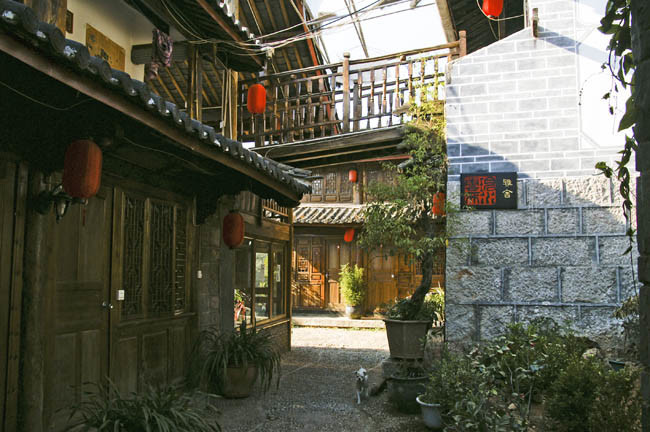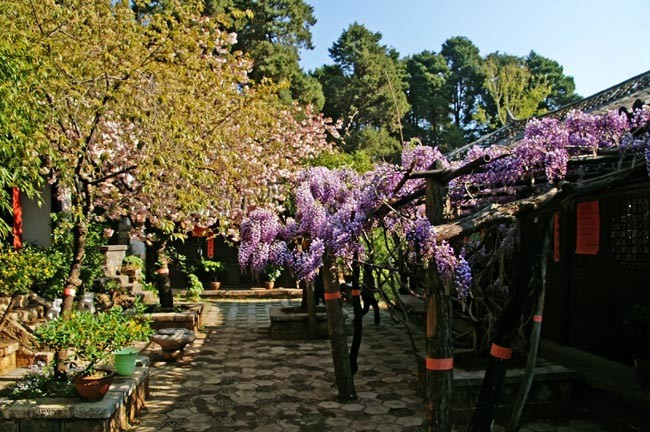Strolling in the graceful Lijiang: Taste Shuhe
Go north from Dayan Ancient City for about four kilometers to reach Shuhe River, known as the Hometown of Qingquan. When Xu Xiake visited Zhishan Liberation Forest, he once walked through this road. In his travel notes, he wrote: "Crossing a dry stream and stone bridge, looking west at the middle sea, dark willows and waves are lingering. There are large settlements on it, which is Shihe Courtyard". "Shihe" is the ancient name of Shuhe today.
Shuhe is called "Shaowu" in Naxi. It is named after the mountain after the village. It means "the village under the peak." It is one of the earliest settlements of Naxi ancestors in Lijiang Bazi. It is the birthplace of the Mu family in Lijiang. It is an important market town well preserved on the ancient tea-horse road. It is also a living specimen of the transition of Naxi ancestors from agricultural civilization to commercial civilization. Shuhe is an important part of the ancient city of Lijiang, a world cultural heritage. In 2005, it was selected as CCTV's "Famous Charming Town in China". The ancient town of Shuhe faces east and west, with the lee facing the sun. The mountain forest behind the village is the remnant of Yulong Mountain to the south. The mountain shape is beautiful and the vegetation is dense. At the foot of the white sand rock, there is Fenghuang Mountain. The mountain shape of Shuhe River changes again, showing an auspicious sign. It is called "The Land of Danfeng Containing Books", predicting the prosperity of culture and prosperity. Not far from the town, there is an archway with a "Danfeng and a book".

Because it is an important town on the ancient tea-horse road, Shuhe Town has always been full of shops.

Some businesses are decorated with very ethnic characteristics.

The style of Shuhe Town is very similar to that of Dayan Town. It is adjacent to the Yulong Snow Mountain and is surrounded by mountains and contains water. The water in Longquan Pond is clearer than the water in Dayan Ancient City. The spring water runs through the streets of the small village. Although the local sewage treatment is poured into the river, people in the village have specific village rules and regulations on the use of water: no debris is allowed to be thrown into the water, no children are allowed to play by the water, no laundry and shoes are allowed upstream, etc. Every morning, it is time to draw drinking water, and the rest of the time, the running water in front of the door is only used for laundry. This ensures that the water quality is not polluted. Although there are no severe sanctions, people consciously abide by them.
Shuhe Ancient Town is another part of Lijiang's "World Cultural Heritage". Nowadays, Dayan Town, the ancient city of Lijiang, is too commercial. This is a "miniature Dayan Ancient City". It is not as prosperous as the ancient city, but quieter than the ancient city. So some people say that if you want to truly taste Lijiang now, you must go to Shuhe, and it is best to find an inn here. Stay for a few days.

There is also a Sifang Street in Shuhe Ancient Town, with a length and width of only more than 30 meters. There are five roads leading to all directions. It is surrounded by water and serves as a city in mid-day. It is one of the oldest markets in Lijiang Bazi. In ancient times, there was a night market on Sifang Street in Shuhe. People strolled on Sifang Street like today's urbanites, stopping and stopping at will, watching the strange things, and eating what they wanted to eat and participating in their favorite games. People visiting the night market held flashlights in their hands and walked along the banks of the Qinglong River, like fireflies on summer nights. It became a scenery called "Night Market Fireflies" and was listed as one of the eight scenic spots in Shuhe.

There is a "Sifang Tingyin" square in the center of Sifang Street. The "Sifang Tingyin" building in the square is magnificent, fully reflecting the characteristics of Naxi, Bai and Tibetan ancient buildings, and is similar to the Mufu buildings in the ancient city of Lijiang. The building is located in the west and east. The square in front of the building is 65 meters long from east to west and 55 meters wide from north to south. The square and streets are paved with five-flower stone strips commonly used by the Naxi people, making them rough and thick. The square is surrounded by water, with weeping willows and fragrant osmanthus. It seems that this is a place for Naxi song and dance performances.

Many restaurants in Shuhe Town are also built along the water, and the waterwheel driven by the creek squeaks, bringing extra fun to diners.

Qinglong Bridge was built during the Wanli Period of the Ming Dynasty and has a history of more than 400 years. To the west is Jubao Mountain. The central axis of Qinglong Bridge is facing Jubao Mountain. This is the design of Mu's Tusi and it is also the landmark of Mu's Tusi's Tusi's heyday. It is 25 meters long, 4.5 meters wide and 4 meters high. It is all built of stones and is listed as the largest ancient stone bridge in Lijiang. In the beginning of spring, the willows beside the bridge have sprouted new buds, like smoke and yarn, as if green waves are about to surge to the bridge deck. This is another of the eight scenic spots of Shuhe River: "Yanliu Ping Bridge". The deck of Qinglong Bridge has been washed by hundreds of years of wind and rain, making it mottled and old, but without losing its heroic momentum and solemnity. Standing here, you may hear the sound of hooves echoing. In the spring morning sunshine, the mottled stones on the bridge deck tell the vicissitudes of time.

Qinglong Qiaotou is an old area of Shuhe Ancient Town. Compared with the new area, these narrow streets can better reflect the original appearance of the ancient town in Lijiang.

There are many tasteful Naxi inns in the old area.


Next to the "Jiuding Dragon Pool", there is a water-facing eaves building built in the Qing Dynasty called the "Sansheng Palace", also known as Longquan Temple, hidden among green trees.

The temple was originally dedicated to Guanyin, Manjusri, and Samannah, and later to Emperor Xuanyuan, Sun Mo, and Monk Baimei. The plaque in front of the building says "Half Day Leisure", which means "another half day of leisure". Leaning on the railing and tilting, looking at the fields in the countryside from a distance, and watching the fish swimming in clear water up close, it makes people feel comfortable. From this door, you can enter the Three Holy Palace.

This delicate cherry tree and purple vine are wrapped in red ropes. It is said that the TV series "Chen Yuanyuan" was filmed here.

All streams in Shuhe Town come from the "Jiuding Longtan". This "three-eye well" is not far from the pool. It is the domestic water source for the residents of the town. The so-called "three-eye well" means that when the well is built, the well water is divided into three parts: upper, middle and lower parts according to different uses from top to bottom, which are used for drinking, washing vegetables and washing respectively. This not only ensures drinking hygiene, but also saves water resources. A wooden sign next to the well is eye-catching. It reads: "Water is good for all things without competing..." In their real life, the hard-working and intelligent Naxi people use the "Three Eyes Well" culture as the "rural rules and regulations", reflecting their reverence for nature and the virtue of harmonious coexistence among people. I have also seen several "three-eye wells" in Daguzhen Town, and this well left the deepest impression.

In Shuhe Ancient Town, I also had a meal at Fuxian Xiaoguo Rice, a popular local time-honored specialty food restaurant. I think it is the best food I have ever tasted in Lijiang. Not only is the environment good, the service is good, the dishes are good, and the prices are so affordable. In the scenic area, it is really hard to imagine that I can meet such a high-cost-effective specialty food restaurant. No wonder so many stars have eaten it. This reputation is not just a celebrity, but a creation. It must be recommended!





After living in Dayan Ancient Town in Lijiang for three days, when I left Lijiang early on the fourth day, the waterwheel next to the square was squeaking in the glory of the spring sun, as if the years were passing by. Perhaps because it was too early, there was no such noise as we had often seen here for days.

The statues on the ancient tea-horse road tell the story of the past in detail.

Everything in Lijiang is so worth remembering! Goodbye, Lijiang, which has a beautiful wind and a strong charm in April!
Previous Article:Meeting Yunnan: Encounter with Girl Lijiang and Goddess Shangri-La
Next Article:Lijiang-a place that makes people forget to leave and relax
